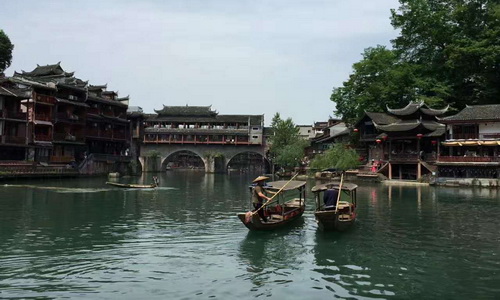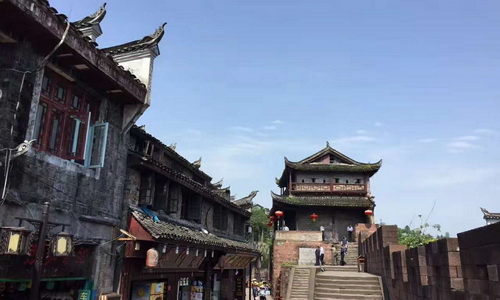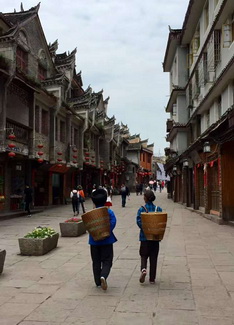Fenghuang Ancient Town
Located in southwest of Hunan Province, Fenghuang Ancient Town (aka Phoenix Ancient Town) has been famed as the most beautiful town of China by Rewi Alley, a famous writer from New Zealand. As a renowned historical and cultural city of over 400 years, Fenghuang is blessed with a far-reaching origin that could be dated back to Kangxi Reign (1661 - 1722). Generations of Miao and Tujia ethnic minorities have been dwelling in the ancient town, and their typical folk residence of wooden stilt houses are well-preserved, which is a big highlight to be cherished by world travelers. Along the flagstone paved narrow lanes hide a number of time-honored monuments and former residences of historical celebrities. Nestled by the serene Tuojiang River, the charm of Fenghuang Ancient Town could be explored by a leisurely boat cruise.

As the largest river in Fenghuang, Tuojiang River is like a glamorous emerald lying by the side of the ancient town. The best way to inhale the beauty of the river is to take a 20-minute cruise floating down from the port near the north gate to Wanshou Palace. With accompany of boatman's folk song, the cruise would take visitors to discover the mottled stilt houses and historical sites like Wanming Pagoda, Duocui Tower, and Wanshou Hall lined on the waterfront. During the slow drifting, you might also spot some sculling fishing boats dotted on the river that stir up glistening ripples. Staying on boat is also one of the perfect ways to shoot the graceful Fenghuang Ancient Town. By the way, the cruise fare is already included in the combo entrance ticket.
With a total length of 100 meters, two rows of stone piers were built to connect the two sides of the Tuojiang River. The rock-hopping piers are arrayed with a distance of 5 meters in between, which are covered with planks and fastened with iron chains. In the middle of the rock-hopping path, you can capture an amazing panoramic view of the river and the folk residence. It might be a bit thrilling to walk cross a river by such a narrow rock path, but piers indeed used to be the main passageways for local's entry and exit. Nowadays you could still see local women dressed in their colorful ethnic costumes with baskets going across the rivers through the rocks.

Originated from Ming and Qing Dynasty, stilted houses in the Fenghuang Ancient Town are traditional folk residences with rich architectural characteristics of Miao and Tujia ethnic minorities. Built along the hill slope and by the waterfront, stilt houses are supported by pillars and columns to suspend high above the ground, which is a smart architectural method to protect the dwellers from snakes, beasts and damp. The best place to appreciate the stilt house complex in Fenghuang is Shawan area, where you could snap a picturesque full view of the old and quaint roofs and windows. Besides, cruising on the river is also a wonderful way to capture awesome pictures of the wooden residences.
Also known as Wind and Rain Bridge, the Rainbow Bridge spanning over Tuojiagn River is the most iconic structure in Fenghuang Ancient Town. Firstly constructed in Hongwu Reign (1370 - 1417) of Ming Dynasty, the Rainbow Bridge is an elegant historical monument that holds the most attractive spots of Fenghuang. There are corridors on the bridge to allow visitors to embrace the refreshing river view. A spectacular Wind and Rain Tower is peached on the bridge, from which you are able to have a bird's eye view of the entire old town. The ground floor of the two-story tower is clustered with small shops, while the second floor is an exhibition place for painting and calligraphy works where you could immerse in the thick cultural atmosphere.
Fenghuang Ancient Town came to be widely known by Chinese travelers because of a famous writer Shen Congwen who wrote a book named Border Town to depict his poetic hometown, Fenghuang. The former residence of him also became a popular cultural attraction, especially for literary lovers who want to commemorate Shen. It is a well-preserved and quaint courtyard with typical Ming-Qing architecture style, where Shen Congwen has spent his merry childhood. In the archaic courtyard display a number of precious historical photographs showcasing the former days of the writer.

Built in 1836, Ancestral Hall of Yang Family is the largest and best-preserved one among all the ancestral halls, which also used to be the former site of Fenghuang County government. Sandwiched between East Gate Tower and the North Gate Tower, the ancestral hall covers an area of over 770 square meters. Yang family was a great clan in Fenghuang, and the ancestral hall was also used as a public place for storytelling and opera performance. Now wing rooms on both sides of the ancestral hall have become small exhibition halls to display daily necessities and handicrafts of Miao people. Meanwhile, for a better cultural inheritance, there are wonderful folk dramas and operas carried on the old stage every day.
Erecting at the northern bank of Tuojiang River, Wanming Pagoda is a seven-storied hexagonal tower with a height of about 22 meters. The richly decorated pagoda used to be a paper furnace. In Ming and Qing dynasties, ancient literati burned down the paper written with characters instead of littering them at will as papers and characters were regarded as holy means to spread knowledge. After the time-weathered damage, the pagoda had been restored, which was sponsored by thousands of local people. Thus the tower was renamed as Wanming Pagoda. The neon-lit Wanming Pagoda at night is more glamorous by casting shimmering reflections on the river, which is definitely a fantastic spot to seize the night charm of Fenghuang.
1. Cars are not allowed inside Fenghuang Ancient Town, so it is a favorable experience to explore the town by leisurely walking.
2. The combo tickets is three days valid, covering 8 main spots of the ancient town, including The Former Residence of Shen Congwen, The Former Residence of Xiong Xiling, Ancestral Hall of Yang Family, Eate Gate Tower, Tuojiang River Boating, Wanshou Palace, Ancient City Wall, Fenghuang Museum and Rainbow Bridge.
3. You could also just purchase single ticket at spot for every individual site that you want to sight-see further.
4. The ancient town is open for 24 hours except for some spots inside which have certain opening hours.
- From Zhangjiajie Central Bus Station, there are regular buses bound for Fenghuang Ancient Town, which takes about 4 hours on the way.
- From Tongren Bus Station (next to Tongren Railway Station), there are frequent buses to Fenghuang Ancient Town with duration of about 1.5 hours.
- From Fengaung County, the public bus No. 1 and No. 3 lead to the ancient town directly.
Type:Private Tour










